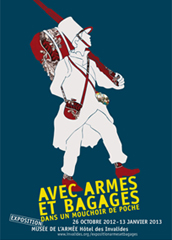Presentation
Introduction to the exhibition
 This exhibition takes the public on an astonishing tour of the day-to-day life of the soldier, and beyond that of French society as a whole, during the 19th and 20th centuries, carried along by the many incarnations of a surprising, little-known object, at the same time mundane and sophisticated: the square of printed fabric known as handkerchief or scarf, depending on the age and the uses to which it was put.
This exhibition takes the public on an astonishing tour of the day-to-day life of the soldier, and beyond that of French society as a whole, during the 19th and 20th centuries, carried along by the many incarnations of a surprising, little-known object, at the same time mundane and sophisticated: the square of printed fabric known as handkerchief or scarf, depending on the age and the uses to which it was put. Neckerchief, pocket handkerchief, printed or delicately embroidered, made of fine cotton or silk, this everyday object nowadays projects a rather outmoded image. However, when studied more closely, the handkerchief has made a vivid impression on our imagination, through its literary or idiomatic associations or its symbolic dimension. Although the term “handkerchief” is nowadays used only in its most mundane sense, this exhibition aims to restore to centre-stage this fabric square which has so much to teach us about the age in which it first made its début.
The square is in reality much more than just an accessory; it may be a rag or a picture, a medical dressing or a fashion accessory, a makeshift nightcap or bundle of possessions. In each of its manifestations it is an object full of meaning and a concrete reminder of the spirit of an age. The kinds of square, its printed designs and its uses also reveal the numerous complex and subtle relationships between military culture and the “civilian” world.
We begin by looking at the printed square as the blank canvas for images drawn from mythology, propaganda or satire.
We then discover it as a teaching tool, featuring a variety of requirements: learning geography, or knowing how to dismantle a rifle, in an age when every citizen was a soldier in the making.
Finally we see it as unique evidence of the “fin de siècle” spirit of the Belle Époque and of the soldier’s place in society, from the flag-bedecked street where he paraded to the theatre which he frequented.










